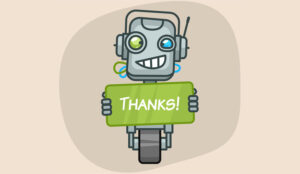Earlier today I stopped by my local supermarket to pick up a few things. After crossing everything off my list, I headed toward the registers. I could have gone to the self-checkout units, which were open and available, but since I was buying an AMEX gift card that required activation and a gift receipt, I decided to go to a register with a real live employee instead.
As I approached the express checkout lane where the clerk was ringing up an employee who, presumably, was on her break, the register light turned off. Apparently he was going on break too. That’s okay. I just went to the register to my right (and now the only manned register available) where the transaction ahead of me was in the coupon deduction stage and about to conclude.
While waiting, I noticed that there were four employees at this register: the clerk, two sackers, and a supervisor whose bright red vest signaled her supervisory-level status. At first I thought about the irony of having to wait with a single register open with four employees in view. Why not, for instance, cross-train and redeploy sackers to operate registers to expedite customer checkout?
As the transaction ahead of me ended and my items were being rung up, the sackers and supervisor suddenly vanished. I then bagged my own groceries. The clerk thanked me for doing so, to which I replied, “That’s alright. I’m used to self-service.”
She then predicted that her own job would soon be replaced by a machine.
To make her feel better, I said, “A machine could never replace your smile.”
Encouraged, she laughed. But her response was telling: “They’re making machines out of us.”
I was disappointed to hear that for a couple of reasons: Whenever employees refer to “us versus them”, whether referring to customers, other departments (shifts, divisions, locations, etc.) or management, it’s not a good thing. And, the reference to machines was disheartening. The implication being, at least from her perspective, that management is telling employees to execute WHAT they want them to do, HOW and WHEN they want them to do it.
That’s exactly what machines do. They execute WHAT you want them to do, HOW and WHEN you want them to do it. For example, my Breville coffee machine will make between a single cup and 12 cups of coffee (although Breville’s definition of a “cup” and my definition are two different things ). The built-in grinder will produce ground beans in varying degrees of texture, from coarse to finely ground. I can select coffee strength using another setting and can also program the exact time for the machine to grind and brew a pot of coffee.
But, do you know what a machine can’t do? Besides being unable to make eye contact, express genuine interest in you as a customer, or smile, it can’t discern WHY it does WHAT it does HOW and WHEN it does it. It has no understanding of purpose or meaning. It only exists to execute an assigned task. And, if managers aren’t careful, they can unwittingly assign job responsibilities that are devoid of meaning and disconnected from organisational purpose and that devalue the contributions of employees by “making machines out of (them).”
Author: Guest Author
Published On: 26th May 2017 - Last modified: 30th May 2017
Read more about - Archived Content





























